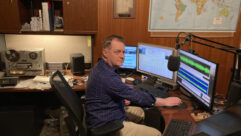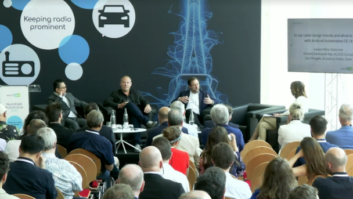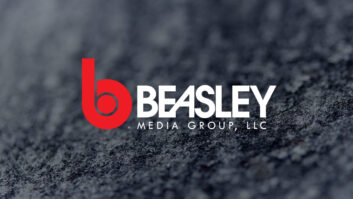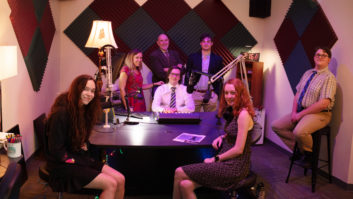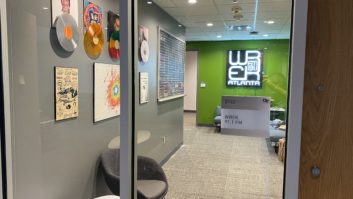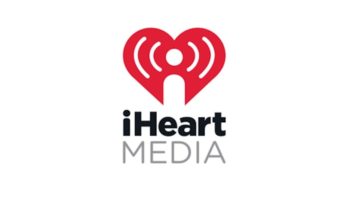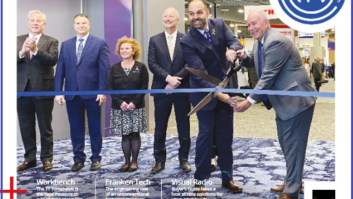Upbeat Digs
Jul 1, 2008 12:00 PM, By Ken Tankel, CSRE CSTE

WNYZ, Brooklyn, NY, was a Russian-language station that operated very much in the old tradition of radio. There was a control room with a board operator/producer, and the show hosts and newscasters sat in front of their microphones in a separate studio space. The equipment was quite up-to-date, including a Comrex Stac phone system and a stand-alone Mediatouch workstation. Production was done in a room designed for producing music beds and beats. The studio had two DAWs, some great synths, but no console. This room supported a full-fledged recording studio where commercials and original music were produced, and finished production was transferred, via LAN, to shared storage. From the shared drive, files could be moved to the stand-alone Mediatouch system. There were no audio or control lines between any of the rooms. But that was yesterday.
Today, WNYZ, which covers Manhattan, Brooklyn, Staten Island, Northern New Jersey, and Southern Connecticut is bringing a new beat to the tri-state area.
Veteran radio programmer, Joel Salkowitz, was hired as the PD and operations manager to program a new dance format and to develop the facility for his new staff. Budget, time frame and functionality were all critical factors in getting the station on the air with the new format. The air staff would be drawn from the established New York radio scene where the talent had the experience and the expectation of good broadcast tools. Informed equipment decisions would allow staff to hit the ground running and also provide flexibility to respond to the station’s growing needs and take advantage of new opportunities.
A place to begin
To accommodate the new format, the facility would get new air and production studios. The existing studio/control room would be used for the morning show. There was no space for a dedicated rack room so it was important for all the centrally located equipment to fit in a single rack. The rack would be located in a small area outside the morning show and air studios. To build the facility as quickly as possible, the new studios would be assembled, wired and tested off site. Space renovations and cable installation could proceed at the same time the studios were being wired. As soon as the new rooms were available, furniture and equipment could be delivered and a working studio system could be quickly completed.
WNYZ chose Radio Systems Millenium Digital consoles for the studios. To further reduce installation time and labor expense, the Studiohub+ wiring was used for the studios and the central rack. The Millenium consoles were supplied Studiohub-ready, with all audio connections available on RJ-45 connectors. Studiohub Mini Tie hubs were used as tie-points between the studios and the central rack. Each hub has two RJ-21 connectors distributed to 24 RJ-45 connections. These are used for 12 analog stereo pairs and 12 AES3 digital audio connections between each studio and the central rack. To eliminate any possibility of crosstalk between AES digital circuits and analog audio circuits, one multi-pair cable carries only analog signals and the second cable carries only digital audio circuits.

WNYZ Production combines a broadcast console with two DAWs. To the left are several synths and a window into a small vocal booth.
Studio Technology furniture, all the new audio equipment and studio accessories were delivered to the integrators’ shop at Future Media Designs. The cables for audio and device control were put in place in the studio furniture prior to delivery to the studios. The consoles, mic booms, microphone controls, headphone amps and cross-connects to the Mini Ties were all installed and tested. In the central rack, cross-connects between the studio tielines and the rack equipment were installed. Wiring for equipment that would be reused from the existing studios was also put in place during the pre-build. Studiohub adapters for audio connections as well as remote control were used throughout, and prefab, shielded CAT-5 cables were used. Studiohub has comprehensive ground/shield management allowing control over the ground system. After each studio and the central rack were wired, the cables were bundled into harnesses and pulled back to the Mini Tie terminations. The equipment was pulled out of the racks with the exception of the Mini Ties and patchfields, which were transported in place in the furniture.
Meanwhile, six lengths of shielded, 25-pair, CAT-5 cable with RJ-21 connectors preinstalled were delivered to WNYZ. Two 25-pair cables were run from each studio to the central rack location. Six individual CAT-6 cables were also run from each studio to the central rack. The individual cables would be used for KVM extender, console remote starts for automation, an ISDN line, a LAN for Internet access and for future use.

The talk studio provides plenty of control for the host including all mic on/off/cough, phone speaker and monitor levels, phone system, and a view of the Media Touch screen.
Something existing, something new
The design called for the studios to share the existing Comrex Stac phone system, so the Stac was moved to the central rack. The two caller outputs run to a DBX 166 compressor/limiter and then to a stereo distribution amp. The DA outputs run, via the tielines, to each of the three studios. The caller mix-minus and program-on-hold outputs from each studio return to a stereo, three-input-by-one-output switch. Any studio can use the phone system by selecting the appropriate mix-minus source to feed the Comrex.
The standalone Mediatouch system was expanded to serve all of the studios. The new system provides playout in the morning show studio; the new air studio, recording in the production room; and scheduling and audition of content in the PD’s office and traffic. The Mediatouch server and studio workstations for the new studios are located in the central rack with KVM extenders into the air and production studios. AES3 digital audio connections are provided via the tielines.
Upbeat Digs
Jul 1, 2008 12:00 PM, By Ken Tankel, CSRE CSTE

The morning show control room has a profanity delay, behind the Short Cut, with a red dump button visible on the console surface.
The furniture and equipment arrived on site on a Monday at 7 a.m. The furniture and central rack were in place and ready for equipment in a matter of hours. The production studio was up and running by the end of the day Tuesday. The air studio was complete at end of business on Thursday. Simply plugging in the two multipair cables in a studio and in the rack instantly provided all the audio interconnect to the central rack and between the studios. Each studio uses approximately 50 percent of the audio capacity in the multipairs. The central rack was complete, and the entire studio system tested by Friday evening. Saturday was spent in the talk studio and control room reprogramming the existing Audioarts D16 console to try and anticipate the needs of the Star And Buc Wild show, retuning to New York radio on WNYZ.
The flexibility of the Millenium was put to the test when the air staff requested changes to record phone calls off-line. Their request was to be able to record phone calls when the callers were not on air, take calls totally hands free, record calls without turning on any console channels, and recording calls without changing program/audition bus assignments. All of this is to avoid any on-air mistakes. The recording was to be split with the studio mics on one channel and the callers on the other, to provide maximum flexibility in editing the calls. The console was quickly programmed to send a pre-fader sum of the studio mics to the 360 Systems Shortcut left channel input, and pre-fader phone callers to the right channel input, whenever the caller one channel is in cue. When the channel is turned on, the left channel feed switches to the phones mix-minus program bus and the right channel switches to the post-fader caller output. Turning a caller channel on turns cue off. By contrast, two external, eight-channel stereo mixers are required to accomplish the same task in the morning show studio.

DJ breaks in the morning show control room mix old and new technology. The green disks are purely timing data sent to the laptop so stored audio can be scratched and played like it is vinyl.
For WNYZ the combination of stand-alone consoles and modular wiring provided a system that met functional requirements, timeline and budget. The system has the additional benefits of being easy to maintain and is adaptable to future needs.
Where did a radio license with coverage of New York City come from in 2008? Pulse 87 is actually the audio carrier for a low-power TV license on channel 6 and is licensed in Brooklyn. The FM, stereo audio for channel 6 TV is receivable on about 85-90 percent of standard FM receivers.
FCC rules allow low-power TV stations to broadcast separate programs on the aural and visual carriers. Because there appears to be no FCC rulemaking contemplated to require low-power TV to move to digital broadcasting, New York will be able to dance to the new beat of WNYZ for some time to come.
Tankel is the principal of Future Media Design,futuremediadesign.com.
Equipment list
Air and production studios
360 Systems Shortcut
Avalon VT 737
Comrex Stac
Crown D-75
Denon DN-C635
Digidesign Pro Tools
Focusrite Voicemaster Pro
Motu 828mkII
Radio Systems Millenium Digital
Shure SM7
Steinberg Midex 8
Studio Technology furniture
Symetrix 528E
Tannoy Reveal 6
Telos Zephyr Xstream
Tripplite 2400
Morning show studio
Air Tools 6100
Audioarts D16
E-V RE-20 microphones
Radio Systems custom switching
Central/shared equipment
Translantech Sound Arianne
Arbitron PPM
Comrex Stac
DBX166
Broadcast Tools 2.6 DA, SS4.1III
Radio Systems RAD-DA6DC
Imediatouch
Middle Atlantic WRK rack
Tripplite 2400
Studiohub+
Some equipment was pre-existing and reused for the new installation




